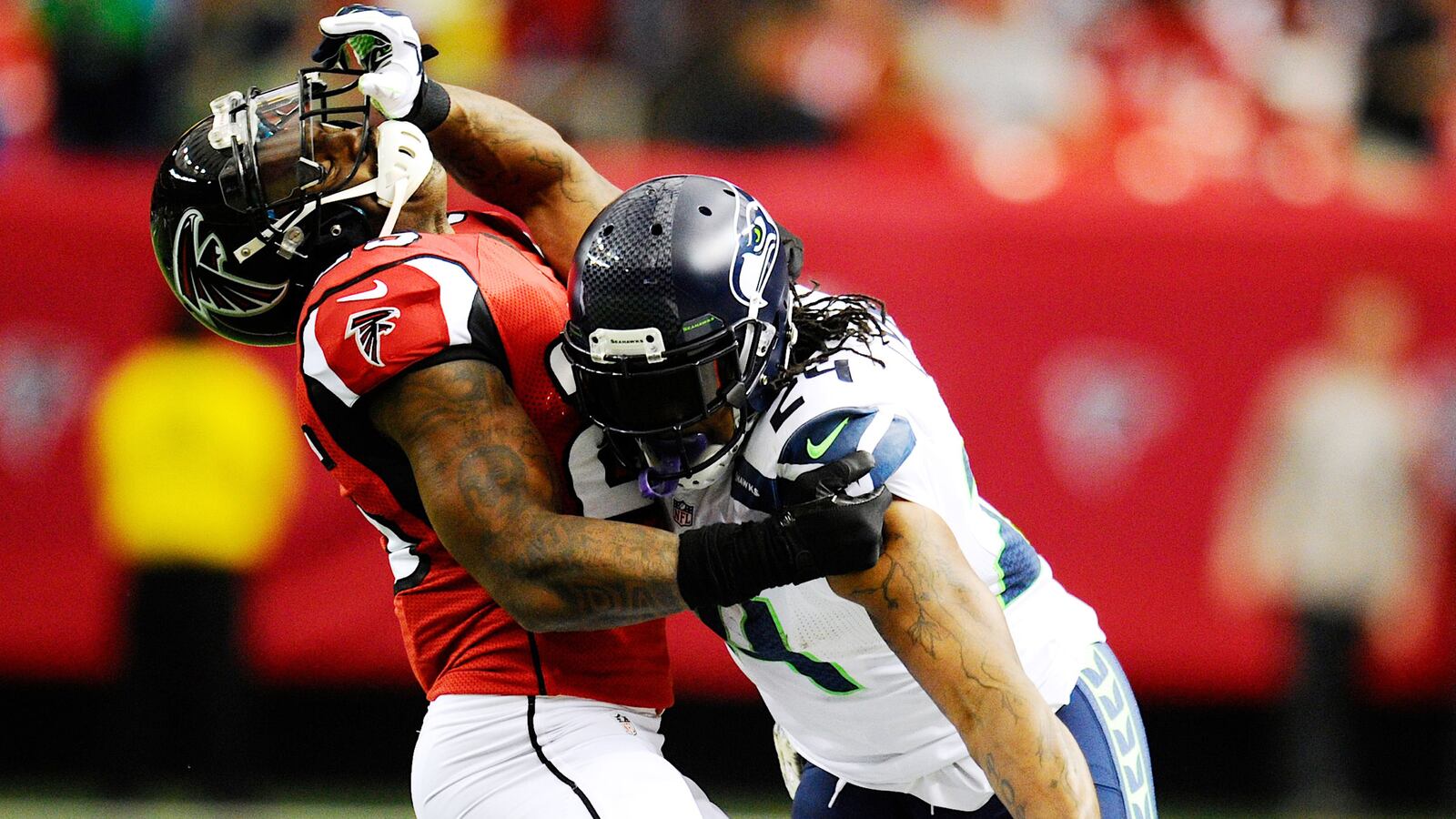Long before studies of former NFL players’ brain tissue shook America’s football-industrial complex to its stem, the sport had undergone other crises involving player safety. In the 1970s, no microscope was needed to see neck and spine injuries among players of all levels were escalating fast. One main culprit was the hard-shell helmet that had essentially become a spearing weapon. Too many coaches were teaching players a head-first form of tackling that left a path of mangled bodies in its wake, sending insurance premiums through the roof.
Rollerball, a movie about a dystopian society fixated with an ultra-violent sport, became an international hit in 1975 and triggered more debate on brutality in sports within the general public. A former Penn State University president became so worried about the direction football was headed he made a plea in the form of a prediction to Joe Paterno, the former Nittany Lions head coach. “Joe, if football doesn’t do something about the injuries, soccer will be our national sport in 10 years.”
This didn’t happen, of course.
It is Manning, not Messi, Sherman, not Suarez, who dominate the headlines before Sunday’s massively anticipated Super Bowl. Denver’s greatest passing offense of all time is on a collision course with Seattle and its most fearsome pass defense in recent history. This here is tectonic heat, a contrast hitting at the heart of why we love sport in the first place. The NFL has most of me in its grasp for this one.
And yet, there is unease. Questions of whether the game’s brutality has gone too far persist. In terms of quantity and severity, there are signs we are on the cusp of the most violent Super Bowl yet.
Start with the increasing size, strength, and speed of players at almost all positions that has contributed to a rise in overall injuries over the last decade—from 2,623 in 2004 to 3,126 in 2012. Kam Chancellor, Seattle’s all-league safety, stands 6’3”, 232 pounds—specs that in the 1950s could have belonged to a defensive tackle. Nobody mixes mass, acceleration, and aggression quite like Chancellor, who appears to have the perfect mindset for somebody paid to do stuff like this.
“When I go out there, all of these hard hits and laying dudes out, that’s just my passion for the game,” he told the Seattle Times. “That’s just showing how much I love this game.”
There’s a lot of love for the game, and disdain for the opponent, in Seattle’s vaunted “Legion of Boom” backfield. Cornerback Richard Sherman, who hardly needs an introduction after the understated charm he evinced in front of interviewer Erin Andrews following last Sunday’s win over San Francisco, is Exhibit A. Sherman told CNN’s Rachel Nichols last week he is far from a barbaric person off the field but knows how to flip the switch on it. “We’re playing a very barbaric sport—you can do as you please, and that’s when I take all of my animosity, all of my anger and all of my frustrations out.”
Denver quarterback Peyton Manning and his cadre of top-notch receivers may yet overpower Seattle’s defense, but they will not do so unscathed.
There is a better chance of John Elway returning to the field as Manning’s backup than there is of the Broncos emerging victorious against these hyperaggressive Seahawks without a few injuries.
***
If football ever dies, it will be an expanded definition of “injury” that kills it.
In the game’s early years, around the turn of the 20th century, hardly anybody questioned what the word meant. Wrenched spinal cords, crushed skulls, and broken ribs that pierced hearts were the immediate and clear results of a game that prized brute strength and did not use protective equipment. “The Chicago Tribune reported that in 1904 alone, there were 18 football deaths and 159 serious injuries, mostly among prep school players,” Christopher Klein wrote for History.com. “The carnage appalled America. Newspaper editorials called on colleges and high schools to banish football outright. ‘The once athletic sport has degenerated into a contest that for brutality is little better than the gladiatorial combats in the arena in ancient Rome,’ opined the Beaumont Express.”
Enter a bunch of rules, at the behest of President Teddy Roosevelt. Over the next decade these rules—abolishing rugby-style mass formations and gang tackling, legalizing the forward pass—preserved football’s popularity and established a foundation ultimately allowing it to overtake baseball as America’s most popular sport.
Another wave of widespread concern led to another round of rule passing in 1979, when the NFL mandated certain equipment be worn by all players during games and deemed use of the helmet to butt, spear or ram an opponent as a violation. Year by year, more and more rules were passed, but the sport appeared to remain just as, if not more, dangerous. Whether it was surging steroid use, or the way AstroTurf could wreck ACL joints, there was always something to fix. But no matter the problem, a solution always seemed just a few regulations away.
That is no longer the case. The concussion issues that have emerged in the last decade are far more nuanced and demand more data than anything the sport has wrestled with before. For instance, decades ago, getting one’s “bell rung” was simply part of the game—end of story. Now, we know it is the symptom of a traumatic brain injury. Get too many of them, too close together, and your life can be ruined. The fact that getting one’s “bell rung” is still part of the game—has to be part of the game—makes whatever story NFL leaders want to spin so much more complicated.
The league, to its credit, has in recent years instituted a host of rules to cut down on the number of high-speed, head-on collisions that most directly lead to concussions. But there can be no rules to limit the subconcussive hits that occur every time bodies this big collide.
If it’s proven the accumulation of all these little hits lead to what is or will be defined as traumatic brain injury—and that that accumulation can happen in as little time as a high school football career—too many mothers will prevent their sons from playing for the sport to stay on top. This scenario, of course, would take decades to play out. And some experts hesitate to label the concussion crisis as the one that will finally K.O. football as we know it. Dr. Thom Mayer, medical director of the NFL Players Association, stresses there is plenty more research left to be done on the topic. “We’re going to go where the science takes us,” Mayer said in a telephone interview. “If we suddenly uncovered that this was just not a safe game to play, then we would state that and be clear about that. It’s my personal opinion that it’s not going to get that far.”
***
I can hardly imagine what it’s like to be Richard Sherman or Kam Chancellor. First of all, let’s not forget—these are people who legitimately claim membership in something called “Legion of Boom.” Moreover, they have physical abilities in a different universe from mine. At first blush, their mindsets are foreign, too. Part of me recoiled when Sherman and Chancellor admitted they put aside their civilized selves and essentially go into seek-and-destroy mode when on the job.
Still, a side of me realizes that without the dark, primal forces, the game of football becomes less beautiful. Peyton Manning’s brilliance, the supreme artistry of those spirals, shine with far less luster in a game of flag football. It is only when he, and his receivers, submit their bodies to the brink of tragedy that I myself feel more alive as a spectator.
The spectacular violence this Super Bowl promises doesn’t attract the better part of me. For now, that’s OK.






